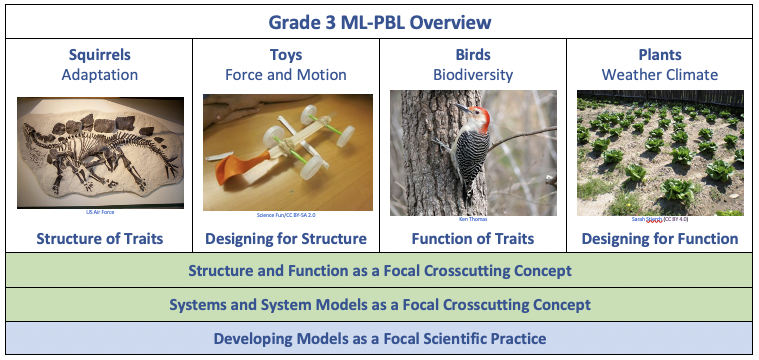Multiple Literacies in Project-Based Learning currently provides integrated project-based science units for Grades 3, 4, and 5. The curriculum for each grade level consists of four units of instruction. Each is framed by a driving question and an anchoring phenomenon, and culminates in a final artifact. Throughout each unit, students are building toward meeting a bundle of NGSS Performance Expectations (PEs). Each lesson focuses on building toward one or more PEs.

Unit Level features include
- Unit Driving Question (DQ)
- Enduring Understanding Statements
- Generalizations
- Overarching Phenomena
- Final Artifact
- Primary and Secondary NGSS PEs
- Embedded applications of CCSS-ELA/Literacy, CCSS-Mathematics
- Featured Social and Emotional Learning (SEL) and Equity Goals
Units are subdivided into Learning Sets framed by questions that build toward the unit DQ. The Unit Table of Contents provides an overview of the Learning Set and Lesson DQs. Unit Learning Progression Charts provide a visual overview.
Driving Question
The Driving Question (DQ) occurs at three levels: the unit level, the learning set level and the lesson level. The Driving Questions gradually and purposefully move students toward using the 3 dimensions of the NGSS to explain and predict the anchoring phenomenon in the unit. The DQs are nested to reinforce coherence. All lesson level DQs can be understood as answering the learning set driving question, and in turn, the unit level DQ.
Lesson Design Features
Lesson design features provide coherence within and across lessons and units.
- 3-Dimensional Learning Performance Statements
- Figuring Out Statements
- Look Fors (Formative Assessment Guidance)
- Discourse Objectives (Moves)
- Lesson Product
- Evidence Statements
Learning Performance Statements. Each Learning Set (LS) and each lesson has a three-dimensional Learning Performance (LP) -- a 3-D learning goal. The learning performance (LP) is assessed at the Look For level, (an informal assessment -- what the teacher is looking for and “noticing”) and the Evidence Statement level, which describes the lesson product as an artifact of the LP (i.e., the final model, the analysis of the data, or the claim). The three dimensions are color-coded to highlight the practice (blue), DCI (orange), and CCC (green).
Figuring Out Statements reflect the DCI elements with respect to their interaction with the phenomenon and with the Driving Question. They represent the heavy cognitive lifting of sense-making expected of the students. We define scientific sensemaking as the dialogic activity of searching for meaning and coherence using scientific and engineering ideas and practices for explaining phenomena and solving problems.
Look For Statements support the collaborative nature of the practices and/or the CCCs with respect to the co-creation of cultural practices and to the lesson level LP. They signal what the students should be doing and (CCC) lenses they should be using as they work together in sensemaking and figuring out. Look Fors also provide guidance for formative assessment – what the teacher is looking for, “noticing,” and prompting for.
Discourse Moves respond to the call in the English Language Proficiency Development (ELPD) Framework for supporting the Language of doing science. The Discourse moves support all of the purposes for engaging in a practice through discourse. For example, after a student expresses an idea while engaging in modeling, the move, “help clarify an idea” means that the teacher would ask questions seeking to make the language more specific and clarify the idea; and so both linguistic and cognitive demand would be supported-- and the purposes of expressing the idea are accomplished.
Evidence Statements provide a description of the tangible/observable product of the lesson. The evidence statement links back to the LP and specifies clearly what should be considered/observed as evidence that students have met the LP (the learning goal of the lesson).
Formative Assessment Opportunities
Formative assessment opportunities are provided through both Look For and Evidence Statements, and the curriculum provides guidance for assessing student progress toward learning goals.
Embedded Language Supports – Differentiation – Scaffolding for Language Development
Throughout the ML-PBL units, we have embedded language supports (support for language acquisition). The most important feature is our integrated and inclusive design approach to English Learners. Supporting teachers in maintaining high expectations of ELs, this feature provides enhanced opportunity for negotiation of meaning as part of situated contexts of science, and focuses on students’ ideas and understandings from a sensemaking stance.
SEL/Equity Goals
As students engage in the NGSS, the sociocultural dimension of the science practices (collaboration, negotiating group and power dynamics, supporting relationships and self-concept) can be furthered at the same time through purposeful scaffolding. Equity goals based on current research are embedded in the lesson-level Learning Performances and are a feature of the LookFors for teachers in the classroom.

